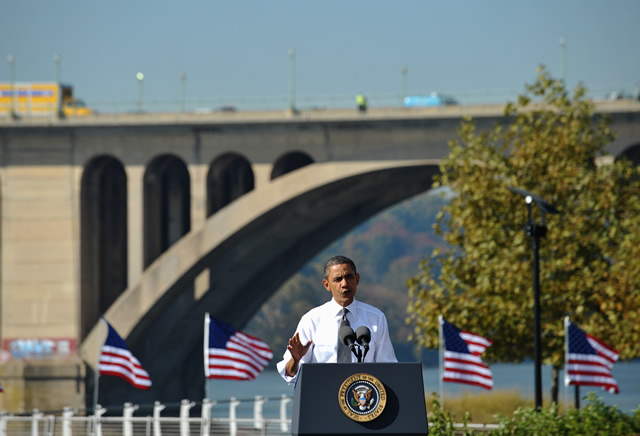Morning Bell: Debunking Obama’s Latest Jobs Myth
Mike Brownfield /
Imagine a high-speed train zooming down hundreds of miles of glistening train track stretching across sunny California, connecting Anaheim to San Francisco. It’s a bullet train dream, and it’s a prime example of President Barack Obama’s latest plan to create jobs in America. The trouble is that this dream is far from reality.
The Los Angeles Times reported this week that the California high-speed train–which is funded in part by $3 billion in federal grants from President Obama’s stimulus–is now expected to cost $98 billion, twice what was expected, and will take an additional 13 years to complete, extending the project to 2033. Questions remain about where the funding will come from, whether the project is viable, and whether the projected ridership will even materialize.
But projects like these are central to President Obama’s plan to put Americans back to work. Speaking yesterday from Georgetown Waterfront Park in Washington, D.C., Obama declared that his plan will “put hundreds of thousands of construction workers back on the job rebuilding our roads, our airports, our bridges and our transit systems.” And that is, of course, all at the expense of the American taxpayers.
The President once called these projects “shovel ready,” meaning that as soon as money arrived from the federal government, workers could be on the job. He made it sound as easy as flipping a switch, but unfortunately it didn’t work as planned. Despite a $787 billion stimulus package, America’s economy continues to languish with 14 million out of work and a 9.1 percent unemployment rate. The President joked, “Shovel-ready was not as shovel-ready as we expected.” Though he didn’t use the phrase “shovel-ready” in his remarks yesterday, the implication was still there. If Congress approves his jobs plan, he argued, all the construction workers sitting on the sidelines will be put back to work overnight.
But that’s not the way things work in the real world. Associated Press and Congressional Research Service reports show that infrastructure spending does not create jobs and, in fact, can even have a negative effect. Heritage’s Patrick Knudsen explains:
Building and repairing roads and bridges neither creates net job growth nor boosts the economy in the near term.
First, increasing government spending on these projects simply moves resources from one place to another — it may employ construction workers, but only by reducing jobs in other sectors. Further, the money never gets out the door soon enough to promote near-term job growth.
And then there’s the President’s flawed argument that since others are doing it, the United States should be, too. “How do we sit back and watch China and Europe build the best bridges and high-speed railroads and gleaming new airports, and we’re doing nothing?” he asks. It’s not a new line of argument from the President, and it leaves out some very important facts.
Dating all the way back to the 2008 presidential campaign, Obama spoke of the need to “invest” in infrastructure in order to be competitive with the likes of China. At the time, Jim Geraghty reported at National Review Online that while Obama puts China on a pedestal, he entirely overlooks some serious problems with transportation in China–namely, stories of severe power shortages affecting the country’s exports, an episode where 500,000 train passengers were left stranded for days, and outbreaks of violence where airplane travelers were left grounded without accommodation. And that’s not to mention the working conditions under which China builds its infrastructure.
Meanwhile, Europe, which heavily subsidizes its passenger rail systems, receives a poor return on its investment. Heritage’s Ron Utt explains that despite massive spending, passengers are opting for more efficient transportation in the air:
In Europe as a whole (EU-27), rail accounted for only 6.1 percent of passenger travel in 2007, including travel by air and sea. Buses accounted for 8.3 percent of the market, and air travel accounted for 8.8 percent. Despite Europe’s huge investment in passenger rail, its market share declined from 6.6 percent in 1995 to 6.1 percent in 2007. Over that same period, commercial air increased its share from 6.3 percent to 8.8 percent. By providing faster service and competitive prices, it took passengers away from rail, buses, and autos.
But to hear President Obama tell the story, building a European- or Chinese-style infrastructure is the key to the future–and to creating new jobs. Workers are ready to go, and all they need is your money to get started. But this is something we tried once already with the last stimulus, it didn’t work, and it’s not going to work this time, either. Obama’s infrastructure plan is a train that shouldn’t leave the station, headed for a bridge to nowhere, and jobs are the last thing that it will deliver.
Quick Hits:
- Thousands of Occupy Wall Street protesters rioted in Oakland yesterday evening — shutting down a busy port, taking over abandoned buildings, setting fires, burning American flags, and destroying ATMs.
- Europe’s leaders threatened to halt aid to Greece until after it votes on a referendum to meet its commitments to the Eurozone. Meanwhile, Greece’s government is reportedly “on the brink of collapse.”
- The Obama Administration considered bailing out solar company Solyndra just before it went bankrupt. The Energy Department would have taken on some of its debt in return for a partial stake in the company.
- Amazon.com is offering to process sales-tax collection for merchants who sell products through its site all for a fee equal to 2.9 percent of the taxes collected. Previously, Amazon lobbied against the imposition of sales taxes on online transactions.
- The State Department has purchased more than $70,000 worth of President Barack Obama’s two books for Christmas “gratuities” and stocking of “key libraries” abroad.

